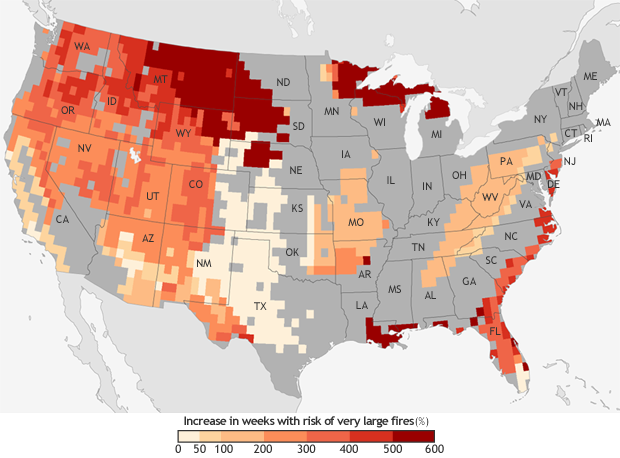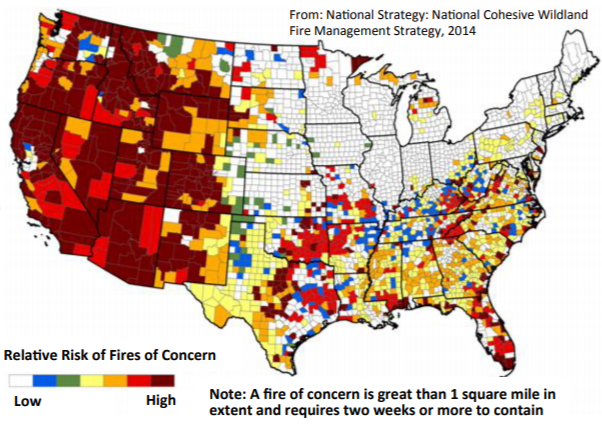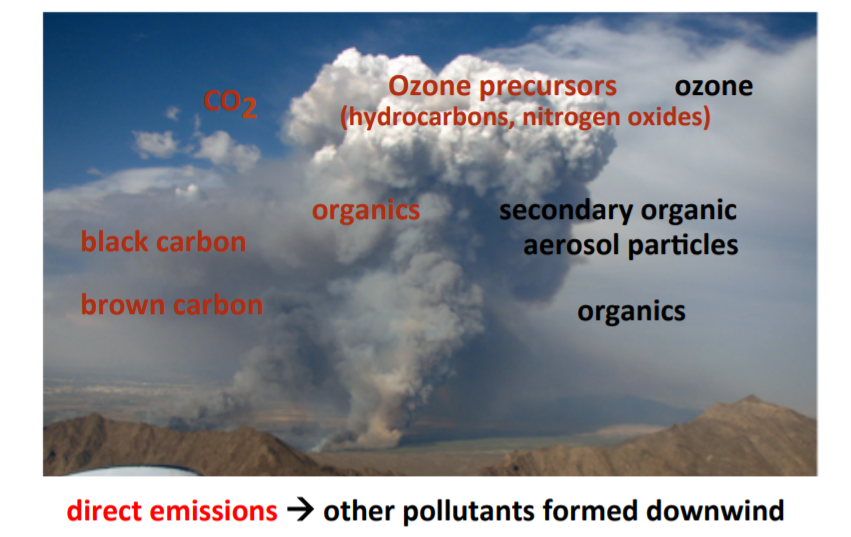Studying Wildfires by Flying Directly Through the Smoke
Special Stories
25 Jul 2018 11:10 AM
From NOAA
Since the mid-1980s, there has been an increase in the frequency and duration of wildfires, especially in the Northwest United States. Understanding how wildfires impact the composition of the planet’s atmosphere and air pollution is becoming increasingly important for citizens all over the region because smoke from wildfires can travel long distances with adverse health impacts on people living nearby and far away.
Over the next two summers, an interagency effort along with multiple universities will take place to study the science behind wildfires. NOAA, NSF, NASA, and other agencies are bringing their talents together to study wildfires in both the laboratory and the field.
 [The projected increase in the number of “very large fire" weeks—weeks in which conditions are favorable to the occurrence of very large fires—by mid-century (2041-2070) compared to the recent past (1971-2000). NOAA Climate map, based on data from Barbera et al, 2015.]
As the 2018 wildfire season comes into full swing, scientists are participating in the first of many field experiments to measure and analyze the wildfire smoke that covers a significant portion of the United States each year. This project, called the Western Wildfire Experiment for Cloud Chemistry, Aerosol Absorption and Nitrogen (WE-CAN), will conduct 15 to 20 smoke-observation flights between late July and August out of Boise, Idaho. Research aircraft will carry 30 different scientific instruments and 18 scientists into the wildfires to make measurements in unprecedented detail.
Led by lead scientist Emily Fischer, at Colorado State, with funding from NSF as well as partial funding from NOAA’s Atmospheric Chemistry, Carbon Cycle, and Climate Program (AC4) and NASA, WE-CAN brings together scientists from five different universities to understand the chemistry of wildfire smoke. Fischer’s primary interest is to understand what happens to the chemistry, composition, and size of the particles when they are first emitted.
[The projected increase in the number of “very large fire" weeks—weeks in which conditions are favorable to the occurrence of very large fires—by mid-century (2041-2070) compared to the recent past (1971-2000). NOAA Climate map, based on data from Barbera et al, 2015.]
As the 2018 wildfire season comes into full swing, scientists are participating in the first of many field experiments to measure and analyze the wildfire smoke that covers a significant portion of the United States each year. This project, called the Western Wildfire Experiment for Cloud Chemistry, Aerosol Absorption and Nitrogen (WE-CAN), will conduct 15 to 20 smoke-observation flights between late July and August out of Boise, Idaho. Research aircraft will carry 30 different scientific instruments and 18 scientists into the wildfires to make measurements in unprecedented detail.
Led by lead scientist Emily Fischer, at Colorado State, with funding from NSF as well as partial funding from NOAA’s Atmospheric Chemistry, Carbon Cycle, and Climate Program (AC4) and NASA, WE-CAN brings together scientists from five different universities to understand the chemistry of wildfire smoke. Fischer’s primary interest is to understand what happens to the chemistry, composition, and size of the particles when they are first emitted.
 What’s different about this field campaign?
Studying wildfires is nothing new; scientists have been doing it for years. What makes this project unique, however, is flying close enough to the wildfire to understand what happens right after the smoke particles and gases from the wildfires are emitted. This will give scientists the opportunity to answer questions such as: How, and how rapidly, do those gases and particles change chemically? How do they evolve within the first few hours of the smoke plume?
To help answer those questions, an instrument aboard the plane, called the Aerosol Mass Spectrometer, collects air from the wildfire as the plane flies through. The Aerosol Mass Spectrometer measures, in real time, the chemical makeup of particles in the wildfire. This allows scientists to develop a better understanding of the composition of the air at the heart of a wildfire.
What’s different about this field campaign?
Studying wildfires is nothing new; scientists have been doing it for years. What makes this project unique, however, is flying close enough to the wildfire to understand what happens right after the smoke particles and gases from the wildfires are emitted. This will give scientists the opportunity to answer questions such as: How, and how rapidly, do those gases and particles change chemically? How do they evolve within the first few hours of the smoke plume?
To help answer those questions, an instrument aboard the plane, called the Aerosol Mass Spectrometer, collects air from the wildfire as the plane flies through. The Aerosol Mass Spectrometer measures, in real time, the chemical makeup of particles in the wildfire. This allows scientists to develop a better understanding of the composition of the air at the heart of a wildfire.
 What happens after the scientists deplane?
After the aircraft flights are over, scientists will begin to analyze the data to better understand how smoke impacts air pollution and climate in the United States. All researchers involved in the WE-CAN project will be working together to synthesize the data and share the outcomes with stakeholders. Bringing together information from the different research groups and investigators is the next step, and this will allow scientists to translate the research into tangible impacts and better inform the public of their findings.
Research findings from flights this year will help NOAA’s FIREX-AQ program conduct their Large-scale Coordinated Intensive Field Study in the summer of 2019 where aircrafts will depart out of Boise, ID and Salina, KS. Flights will be from July to September.
Edited for WeatherNation by Meteorologist Mace Michaels
What happens after the scientists deplane?
After the aircraft flights are over, scientists will begin to analyze the data to better understand how smoke impacts air pollution and climate in the United States. All researchers involved in the WE-CAN project will be working together to synthesize the data and share the outcomes with stakeholders. Bringing together information from the different research groups and investigators is the next step, and this will allow scientists to translate the research into tangible impacts and better inform the public of their findings.
Research findings from flights this year will help NOAA’s FIREX-AQ program conduct their Large-scale Coordinated Intensive Field Study in the summer of 2019 where aircrafts will depart out of Boise, ID and Salina, KS. Flights will be from July to September.
Edited for WeatherNation by Meteorologist Mace Michaels
 [The projected increase in the number of “very large fire" weeks—weeks in which conditions are favorable to the occurrence of very large fires—by mid-century (2041-2070) compared to the recent past (1971-2000). NOAA Climate map, based on data from Barbera et al, 2015.]
As the 2018 wildfire season comes into full swing, scientists are participating in the first of many field experiments to measure and analyze the wildfire smoke that covers a significant portion of the United States each year. This project, called the Western Wildfire Experiment for Cloud Chemistry, Aerosol Absorption and Nitrogen (WE-CAN), will conduct 15 to 20 smoke-observation flights between late July and August out of Boise, Idaho. Research aircraft will carry 30 different scientific instruments and 18 scientists into the wildfires to make measurements in unprecedented detail.
Led by lead scientist Emily Fischer, at Colorado State, with funding from NSF as well as partial funding from NOAA’s Atmospheric Chemistry, Carbon Cycle, and Climate Program (AC4) and NASA, WE-CAN brings together scientists from five different universities to understand the chemistry of wildfire smoke. Fischer’s primary interest is to understand what happens to the chemistry, composition, and size of the particles when they are first emitted.
[The projected increase in the number of “very large fire" weeks—weeks in which conditions are favorable to the occurrence of very large fires—by mid-century (2041-2070) compared to the recent past (1971-2000). NOAA Climate map, based on data from Barbera et al, 2015.]
As the 2018 wildfire season comes into full swing, scientists are participating in the first of many field experiments to measure and analyze the wildfire smoke that covers a significant portion of the United States each year. This project, called the Western Wildfire Experiment for Cloud Chemistry, Aerosol Absorption and Nitrogen (WE-CAN), will conduct 15 to 20 smoke-observation flights between late July and August out of Boise, Idaho. Research aircraft will carry 30 different scientific instruments and 18 scientists into the wildfires to make measurements in unprecedented detail.
Led by lead scientist Emily Fischer, at Colorado State, with funding from NSF as well as partial funding from NOAA’s Atmospheric Chemistry, Carbon Cycle, and Climate Program (AC4) and NASA, WE-CAN brings together scientists from five different universities to understand the chemistry of wildfire smoke. Fischer’s primary interest is to understand what happens to the chemistry, composition, and size of the particles when they are first emitted.
 What’s different about this field campaign?
Studying wildfires is nothing new; scientists have been doing it for years. What makes this project unique, however, is flying close enough to the wildfire to understand what happens right after the smoke particles and gases from the wildfires are emitted. This will give scientists the opportunity to answer questions such as: How, and how rapidly, do those gases and particles change chemically? How do they evolve within the first few hours of the smoke plume?
To help answer those questions, an instrument aboard the plane, called the Aerosol Mass Spectrometer, collects air from the wildfire as the plane flies through. The Aerosol Mass Spectrometer measures, in real time, the chemical makeup of particles in the wildfire. This allows scientists to develop a better understanding of the composition of the air at the heart of a wildfire.
What’s different about this field campaign?
Studying wildfires is nothing new; scientists have been doing it for years. What makes this project unique, however, is flying close enough to the wildfire to understand what happens right after the smoke particles and gases from the wildfires are emitted. This will give scientists the opportunity to answer questions such as: How, and how rapidly, do those gases and particles change chemically? How do they evolve within the first few hours of the smoke plume?
To help answer those questions, an instrument aboard the plane, called the Aerosol Mass Spectrometer, collects air from the wildfire as the plane flies through. The Aerosol Mass Spectrometer measures, in real time, the chemical makeup of particles in the wildfire. This allows scientists to develop a better understanding of the composition of the air at the heart of a wildfire.
 What happens after the scientists deplane?
After the aircraft flights are over, scientists will begin to analyze the data to better understand how smoke impacts air pollution and climate in the United States. All researchers involved in the WE-CAN project will be working together to synthesize the data and share the outcomes with stakeholders. Bringing together information from the different research groups and investigators is the next step, and this will allow scientists to translate the research into tangible impacts and better inform the public of their findings.
Research findings from flights this year will help NOAA’s FIREX-AQ program conduct their Large-scale Coordinated Intensive Field Study in the summer of 2019 where aircrafts will depart out of Boise, ID and Salina, KS. Flights will be from July to September.
Edited for WeatherNation by Meteorologist Mace Michaels
What happens after the scientists deplane?
After the aircraft flights are over, scientists will begin to analyze the data to better understand how smoke impacts air pollution and climate in the United States. All researchers involved in the WE-CAN project will be working together to synthesize the data and share the outcomes with stakeholders. Bringing together information from the different research groups and investigators is the next step, and this will allow scientists to translate the research into tangible impacts and better inform the public of their findings.
Research findings from flights this year will help NOAA’s FIREX-AQ program conduct their Large-scale Coordinated Intensive Field Study in the summer of 2019 where aircrafts will depart out of Boise, ID and Salina, KS. Flights will be from July to September.
Edited for WeatherNation by Meteorologist Mace MichaelsAll Weather News
More